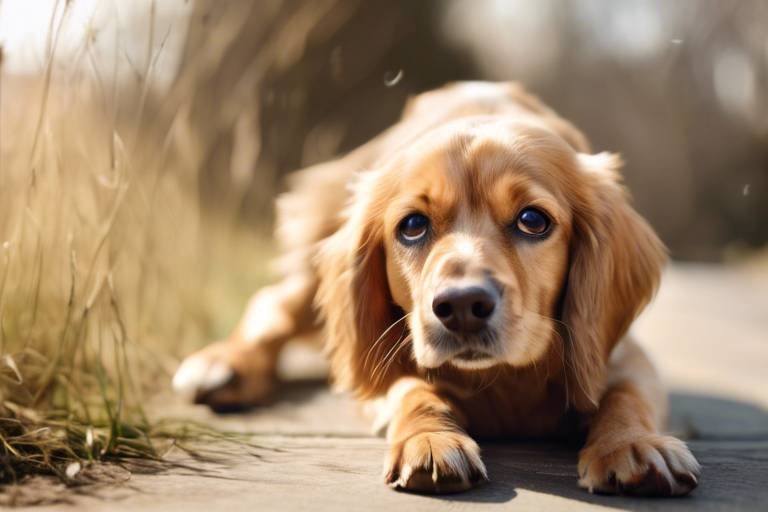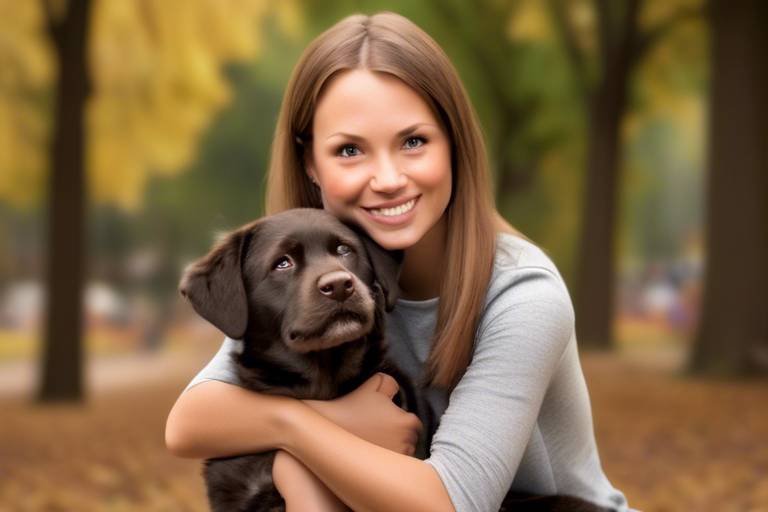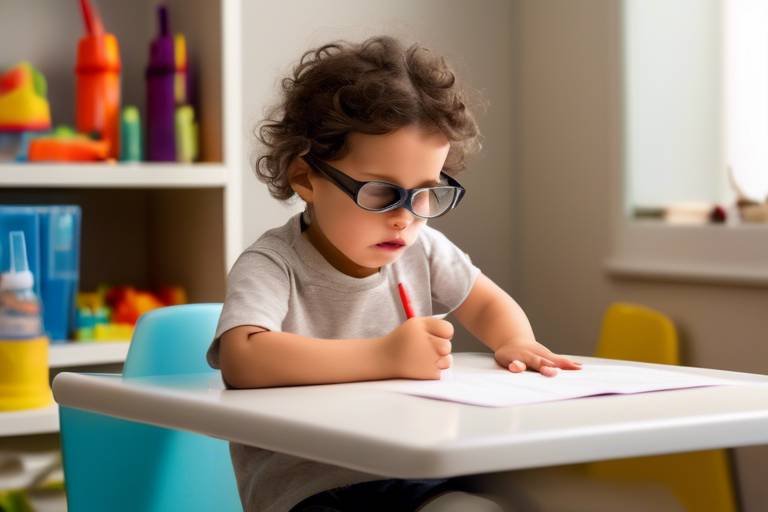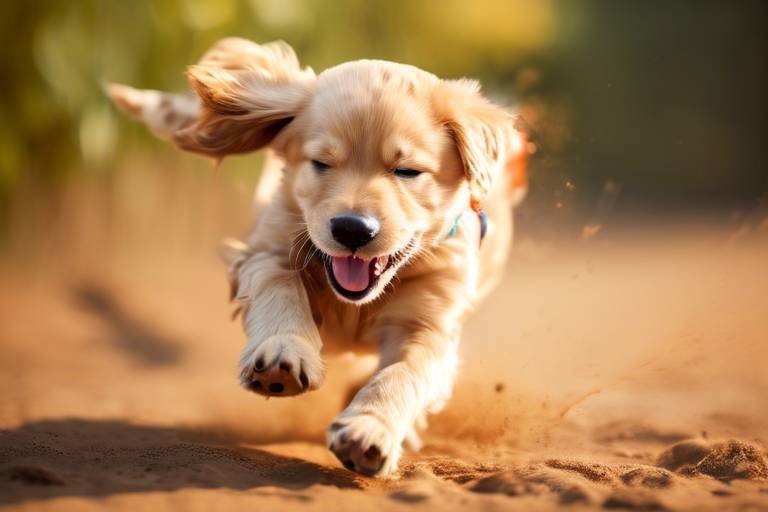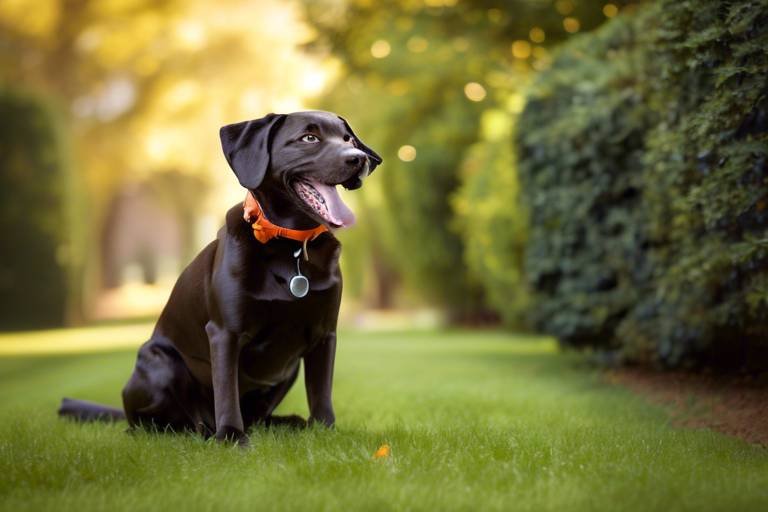Tips for Teaching Your Dog to Be a Greeter
Have you ever walked into a friend's house, only to be met by a furry ball of excitement? Imagine that being your dog! Training your dog to be a friendly greeter can turn your home into a welcoming haven for guests. Not only does it enhance your dog's social skills, but it also creates a warm atmosphere where everyone feels at home. So, how do you get started on this delightful journey? In this article, we’ll explore effective strategies that will help your dog master the art of greeting, ensuring they are not just friendly but also well-behaved. Let’s dive in!
To effectively train your dog, it's essential to have a foundational knowledge of dog behavior. Dogs perceive their environment through their senses, and their reactions can vary based on their past experiences. For instance, a dog that has had positive interactions with guests will likely be more welcoming than one that hasn't. This is where **socialization** comes into play. By exposing your dog to various people and situations, you're helping them develop a welcoming demeanor. Think of it like teaching a child to be friendly; the more experiences they have, the more comfortable they become in social settings.
Creating a suitable training environment can significantly enhance your dog's learning experience. A calm, distraction-free space is crucial for effective greeter training. Start by designating an area in your home where your dog can focus without interruptions. This could be a quiet room or a cozy corner. Remember, the goal is to minimize distractions while maximizing comfort. You might want to consider the following:
- Ensure the area is quiet and free from loud noises.
- Remove any items that could distract your dog, like toys or other pets.
- Make it comfortable with a soft mat or bed where your dog can relax.
Designating a safe space is vital for your dog’s comfort during training. This area should be inviting and familiar, allowing your dog to feel secure. A safe space helps reduce anxiety, making it easier for your dog to learn. You can create this space by:
- Using their favorite blanket or bed.
- Adding toys that they love to play with.
- Ensuring it's a place where they can retreat if they feel overwhelmed.
Positive reinforcement is a game-changer in dog training. It involves rewarding your dog for good behavior, which encourages them to repeat those actions. When training your dog to be a greeter, consider using treats, praise, or even playtime as rewards. For example, when your dog approaches a guest calmly, shower them with affection or give them a tasty treat. This method not only reinforces good behavior but also builds a strong bond between you and your dog.
Introducing your dog to guests gradually can ease their anxiety and help them adjust to new people. Start with close friends or family members who are familiar with your dog. Allow your dog to observe from a distance before approaching. As they become more comfortable, you can gradually increase the number of guests and the level of interaction. This slow introduction can make a world of difference, turning your dog into a confident greeter.
Teaching basic commands is essential for good behavior. Commands like "sit," "stay," and "down" can help your dog learn how to greet guests politely and confidently. Start with one command at a time, ensuring your dog understands it before moving on to the next. Consistency is key here; practice regularly and be patient. Over time, your dog will associate these commands with positive experiences during greetings.
Socialization is crucial for a friendly greeter. Exposing your dog to various environments, people, and other pets can enhance their comfort and confidence. Consider the following socialization techniques:
- Take your dog to parks where they can meet other dogs and people.
- Enroll them in obedience classes where they can interact with other pets.
- Invite friends over to help your dog practice greeting in a controlled setting.
Organizing playdates and attending group classes can significantly improve your dog's social skills. These activities provide opportunities for your dog to interact with other animals and people, reinforcing positive behaviors. Plus, it’s a fun way for both you and your dog to bond with others!
Tracking your dog's progress is essential for effective training. Keep a journal to assess your dog's behavior and note any improvements or setbacks. This will help you make necessary adjustments to the training process. Remember, every dog learns at their own pace, so be patient and celebrate the small victories!
Q: How long does it take to train my dog to be a greeter?
A: The time it takes varies by dog, but with consistent training, you can see progress within a few weeks.
Q: What if my dog is shy or anxious around guests?
A: Gradual exposure and positive reinforcement can help ease anxiety. Consider consulting a professional trainer if needed.
Q: Can all dogs be trained to be greeters?
A: Yes, most dogs can learn to greet guests positively with the right training and socialization techniques.
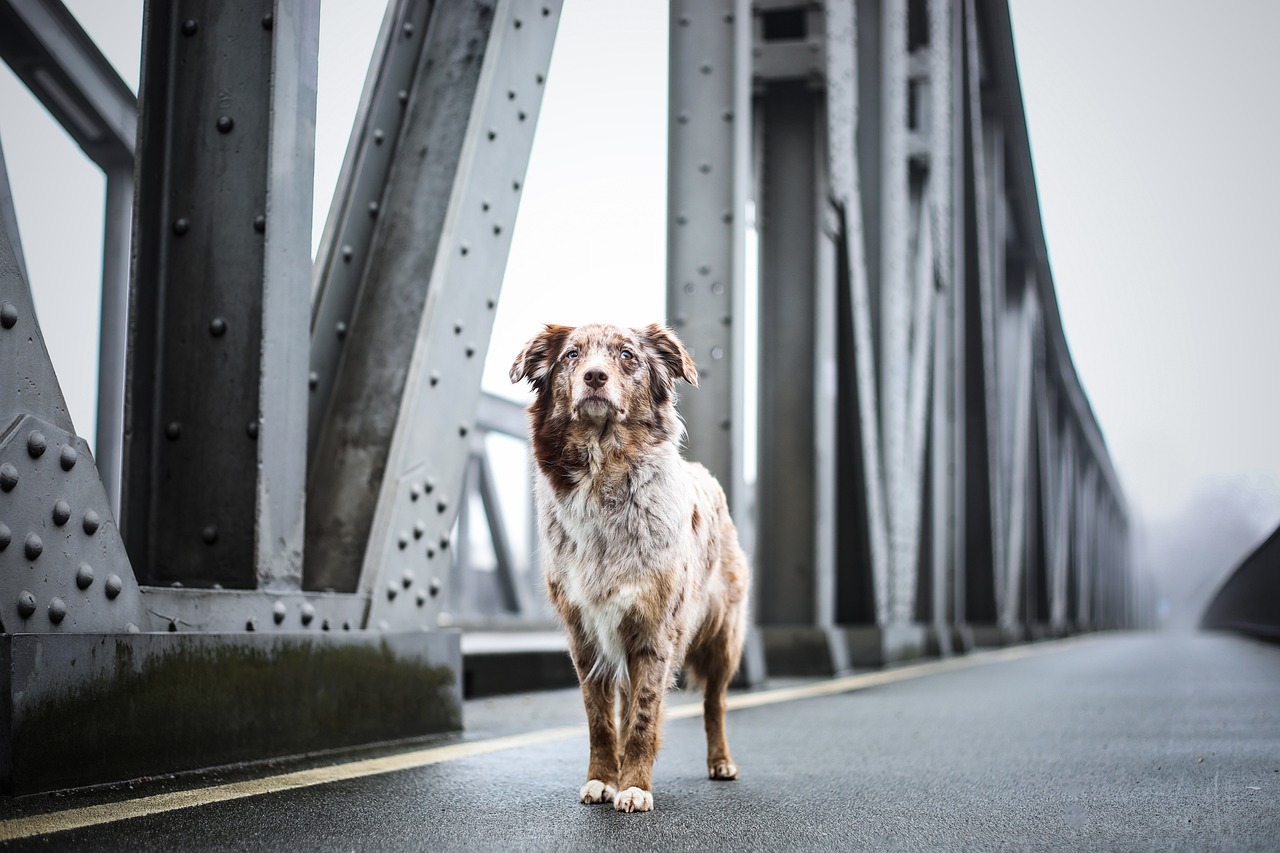
Understanding Dog Behavior
To effectively train your dog to be a welcoming greeter, it’s essential to first grasp the intricacies of dog behavior. Dogs are incredibly perceptive creatures, and their understanding of the world around them is heavily influenced by their senses. They primarily rely on their sense of smell, which is far superior to that of humans. This means that when your dog greets guests, they are not just seeing them; they are also gathering a wealth of information through their nose. Imagine walking into a room filled with various scents—each one telling a story about the person who just entered!
Moreover, dogs are social animals by nature. They thrive on interaction and companionship, which is why socialization plays a pivotal role in their development. A well-socialized dog is more likely to approach guests with a wagging tail and a friendly demeanor. In contrast, a dog that has had limited exposure to new people or environments may respond with fear or aggression. Thus, understanding your dog's past experiences and their comfort level with different stimuli is crucial. Think of socialization as exposing your dog to a new world—the more they experience, the better equipped they are to handle various situations.
When training your dog to greet guests, it's important to consider their body language. Dogs communicate their feelings through posture, tail position, and facial expressions. For instance, a relaxed dog will have a loose body, wagging tail, and soft eyes, while a dog that feels threatened may exhibit stiff posture, raised hackles, or a tucked tail. Recognizing these signs can help you assess how your dog feels about new people. The goal is to encourage a welcoming attitude rather than a defensive one.
To foster a friendly greeting behavior, consider these key aspects of dog behavior:
- Socialization: Regularly introduce your dog to new people, environments, and other animals.
- Positive Experiences: Ensure that every encounter with guests is positive, using treats and praise to reinforce good behavior.
- Body Language Awareness: Learn to interpret your dog's body language to gauge their comfort level.
In conclusion, understanding dog behavior is the cornerstone of teaching your furry friend to be a delightful greeter. By recognizing their natural instincts, social needs, and body language, you can create a training approach that resonates with your dog, making the process both enjoyable and effective. Remember, patience and consistency are key—every dog is unique and will learn at their own pace!

Choosing the Right Environment
When it comes to training your dog to be a friendly greeter, the environment you choose plays a crucial role. Think of your home as a stage where your dog will learn to perform. A well-set stage can make all the difference in their ability to shine. The right environment minimizes distractions and maximizes comfort, allowing your dog to focus on learning how to greet guests in a polite and inviting manner.
Start by identifying a space within your home that is both quiet and free from interruptions. This could be a cozy corner of your living room or a dedicated training area in your backyard. Ensure that this space is familiar to your dog, as familiarity breeds comfort. You want your dog to feel secure and relaxed, so they can fully engage in the training process.
To create an optimal learning environment, consider the following elements:
- Minimize Noise: Choose a location that is away from loud appliances, traffic, or other distractions. A calm atmosphere will help your dog stay focused.
- Comfortable Flooring: Dogs often feel more at ease on soft surfaces. If possible, use rugs or mats to create a cozy training area.
- Proper Lighting: Ensure the area is well-lit but not overly bright. Natural light is ideal, as it creates a warm and inviting space.
- Safety First: Remove any hazards that could cause injury, such as sharp objects or fragile items. A safe environment is essential for building your dog's confidence.
Once you have chosen the right environment, it’s also important to establish a routine. Dogs thrive on consistency, so try to conduct training sessions at the same time each day. This helps your dog understand that it’s time to focus and learn. Additionally, consider the temperature of the environment; a comfortable climate will keep your dog from becoming distracted due to discomfort.
As you progress in your training, you can gradually introduce elements that mimic real-life scenarios. For example, you might start with just family members entering the space before inviting friends over. This gradual exposure helps your dog adapt to the idea of greeting guests without overwhelming them. Remember, the goal is to create a positive association with the environment where they will greet others.
In conclusion, choosing the right environment is not just about finding a quiet spot; it’s about creating a nurturing space that encourages learning and confidence. By paying attention to these details, you set the stage for your dog to become the best greeter they can be, making every guest feel welcomed and cherished.
Establishing a Safe Space
Creating a safe space for your dog is essential when training them to be a delightful greeter. Think of it as crafting a cozy little nook where your furry friend can feel completely at ease. Just like how we all have our favorite spots to unwind after a long day, dogs also benefit from having a designated area that serves as their sanctuary. This space should be away from the hustle and bustle of your home, allowing your dog to relax and focus on the training ahead.
To establish this safe haven, you'll want to consider a few key elements:
- Comfortable bedding: Provide a soft bed or blanket where your dog can curl up. This will help them feel secure and relaxed.
- Familiar scents: Include items that carry your scent or their favorite toys. Familiarity can significantly reduce anxiety and make them feel at home.
- Quiet location: Choose a spot that is relatively quiet, away from loud noises or distractions. This will help your dog concentrate during training sessions.
Once you've set up the safe space, it's important to introduce your dog to it gradually. Start by encouraging them to explore the area on their own. Use treats and praise to create positive associations with the space. For example, if your dog enters the area, shower them with affection and rewards. This will help them understand that this space is a place of comfort and safety.
Additionally, consider incorporating some calming elements into the safe space. You might want to add a few toys that engage their mind or even a soothing music playlist designed for dogs. Just like humans, dogs can benefit from a peaceful ambiance, which can help them relax further.
Over time, your dog will come to recognize this area as their personal retreat, making them more receptive to training sessions. Remember, consistency is key. The more you reinforce the idea that this is a safe space, the more confident your dog will become in their role as a greeter. So, take the time to build this sanctuary, and watch as your dog blossoms into the friendly and well-behaved greeter you've always wanted!
Q: How long should I leave my dog in their safe space during training?
A: Start with short periods, around 5-10 minutes, and gradually increase the duration as your dog becomes more comfortable.
Q: Can I use the safe space for other training activities?
A: Absolutely! The safe space can be used for various training activities, as long as it remains a positive environment for your dog.
Q: What if my dog doesn't want to go to their safe space?
A: Use treats, toys, and encouragement to entice them. Make it a fun experience, and they will likely start to enjoy it.
Using Positive Reinforcement
When it comes to training your dog to be a fantastic greeter, positive reinforcement is your best friend. This technique is all about rewarding your pup for good behavior, reinforcing the idea that being friendly and welcoming is a great way to earn treats, praise, or playtime. Think of it as a high-five for your dog every time they do something right! Instead of punishing unwanted behaviors, you focus on highlighting the good ones. This creates a happier and more motivated learner.
So, how do you implement positive reinforcement effectively? Start by identifying what motivates your dog the most. Is it tasty treats, a favorite toy, or perhaps a good belly rub? Once you know what gets their tail wagging, you can use it as a reward during training sessions. For example, when your dog greets a guest calmly without jumping or barking, immediately reward them with a treat and lots of enthusiastic praise. This helps them associate the calm behavior with something positive.
It's also crucial to be consistent. Dogs thrive on routine, so make sure you reward the same behavior every time. If they manage to sit politely when someone enters your home, that's the moment to shower them with love and treats. Over time, your dog will start to understand that being a polite greeter is the way to go. Remember, consistency breeds success!
As you progress, you might want to phase out the treats gradually, replacing them with verbal praise or affection. This transition will help your dog learn that being a great greeter is rewarding in itself, not just because of the treats. In essence, you're teaching them that being friendly and well-behaved is a lifestyle choice, not just a training exercise.
To give you a clearer picture, here's a table summarizing the key points of using positive reinforcement:
| Step | Description |
|---|---|
| Identify Rewards | Find out what motivates your dog the most—treats, toys, or affection. |
| Consistent Rewards | Reward the same good behavior every time to reinforce learning. |
| Gradual Transition | Slowly replace treats with verbal praise or affection as your dog learns. |
In conclusion, using positive reinforcement not only helps your dog learn how to greet guests but also strengthens the bond between you and your furry friend. It transforms training into a fun and rewarding experience for both of you, making your home a welcoming place for everyone.
- What is positive reinforcement? Positive reinforcement is a training method that rewards desired behaviors to encourage their repetition.
- How long does it take to train my dog to be a greeter? The time varies depending on the dog, but consistency and patience can lead to results in a few weeks.
- Can I use toys as rewards? Absolutely! Many dogs respond well to toys as a form of positive reinforcement.
- What if my dog is not motivated by treats? Try different types of rewards, such as playtime or affection, to see what works best for your dog.
Gradual Exposure to Guests
When it comes to training your dog to be a friendly greeter, is key. Think of it like introducing a shy friend to a party; you wouldn't throw them into the crowd all at once, right? Instead, you would ease them into the situation, allowing them to become comfortable over time. The same principle applies to your furry companion. Start with familiar faces—friends or family members your dog already knows. This helps create a positive association with the arrival of guests.
Begin by having your guests enter your home calmly and quietly, avoiding any sudden movements or loud greetings that might startle your dog. Allow your dog to observe from a distance, giving them the chance to assess the new person without feeling overwhelmed. You can even use treats to reward your dog for remaining calm during this initial introduction. As your dog becomes more comfortable, gradually decrease the distance between them and your guests. This slow approach helps build your dog's confidence, ensuring they feel secure in their environment.
As you progress, introduce your dog to different types of guests. Consider factors such as:
- Age: Young children may move quickly and make sudden noises, while older adults may be more subdued.
- Gender: Different people may have different scents and energy levels.
- Appearance: Some guests may wear hats or sunglasses, which can be unfamiliar to your dog.
By exposing your dog to a variety of individuals, you help them learn to greet all types of people with a friendly demeanor. Remember, the goal is to create a positive experience for your dog every time a guest arrives. If your dog shows signs of anxiety or stress, take a step back and allow them to retreat to their safe space. This is where the earlier established safe space comes into play, providing your dog a retreat where they can feel secure.
Finally, don't forget to celebrate small victories! Each time your dog successfully greets a guest without anxiety, shower them with praise and treats. This reinforces the idea that meeting new people is a positive experience. Over time, with consistent practice and patience, your dog will transform into the perfect greeter, making every guest feel welcome and loved.
- How long does it take to train my dog to be a greeter?
Training duration varies by dog, but with consistent practice, you can see improvement in a few weeks. - What if my dog is aggressive towards guests?
Consult a professional trainer or behaviorist to address aggression issues safely and effectively. - Can I use toys as rewards during training?
Absolutely! If your dog prefers toys over treats, use them as positive reinforcement.
Developing Basic Commands
When it comes to training your dog to be a delightful greeter, is absolutely essential. Think of these commands as the building blocks of your dog's behavior. Just like humans learn to communicate effectively, dogs need to understand a few key phrases to interact well with guests. The most common commands that can help your dog greet visitors politely include sit, stay, come, and leave it. These commands not only help in managing your dog's excitement but also establish a sense of order during greetings.
Imagine this: your friend walks through the door, and instead of jumping up and barking, your dog calmly sits and waits for permission to greet. This is where the magic happens! To teach these commands, consistency is key. Start with short training sessions—about 5 to 10 minutes—so your dog can maintain focus without getting overwhelmed. Use a calm tone and clear hand signals to reinforce what you are teaching. For instance, when you say "sit," gently push down on your dog's rear while guiding them into the position. Once they comply, shower them with praise and a treat. This positive reinforcement acts like a high-five for your dog, making them eager to learn more.
In addition to the basic commands, you can incorporate some fun variations to keep your dog engaged. For example, after mastering "sit," you can teach "sit pretty," where your dog balances on their hind legs for a few seconds. This not only impresses your guests but also builds your dog's confidence. Remember, the goal is to create a friendly and inviting atmosphere, so always reward good behavior.
It's also important to practice these commands in different settings. Once your dog is comfortable at home, try practicing in your yard or a nearby park. This helps your dog generalize the commands, making them more reliable in various situations. The more experiences your dog has, the better they will be at greeting guests with confidence and poise.
As you progress, you might want to introduce distractions, such as having a friend walk in while you practice the commands. This simulates the real-life scenario of a guest arriving and helps your dog learn to focus on you rather than the excitement of a new person. Over time, your dog will associate guests with positive experiences, making them more inclined to greet visitors in a friendly manner.
In conclusion, developing basic commands is a crucial step in transforming your dog into the perfect greeter. With patience, consistency, and plenty of positive reinforcement, you'll see your furry friend shine in their new role. Remember, every dog is unique, so tailor your training approach to suit your dog's personality and pace. Happy training!
- How long does it take to teach my dog basic commands? - The time can vary greatly depending on the dog and the owner's consistency. Some dogs may learn in a few days, while others may take weeks.
- What if my dog doesn't respond to commands? - Stay patient! Make sure you're using positive reinforcement and try to eliminate distractions during training sessions.
- Can I train my dog without treats? - Absolutely! While treats are effective, you can also use toys, praise, or playtime as rewards.
- What if my dog is too excited to focus? - If your dog is overly excited, try exercising them beforehand to help them burn off some energy.

Socialization Techniques
When it comes to transforming your dog into a welcoming greeter, socialization is key. Think of socialization as your dog's way of learning the ropes of interacting with the world around them. Just like humans, dogs thrive on experiences and interactions. The more varied their experiences, the more confident and well-adjusted they become. So, how do we go about this? Let’s dive into some effective socialization techniques that will make your dog the life of the party!
First off, one of the best ways to socialize your dog is through playdates. Organizing playdates with other friendly dogs can create a relaxed environment for your pup to learn how to interact. During these playdates, your dog will learn to read body language, understand social cues, and develop their greeting skills. Remember, it’s not just about playing; it’s about learning how to be a polite participant in the canine community. Make sure to supervise these interactions to ensure they remain positive.
Additionally, attending group classes can significantly enhance your dog’s social skills. These classes are not just for obedience training; they are a golden opportunity for your dog to meet new people and other dogs in a controlled setting. The structured environment helps your dog to focus while learning essential commands and social behaviors. Plus, it’s a great way for you to bond with your furry friend while also connecting with other dog owners!
Another effective technique is to expose your dog to various environments. This means taking them to different places where they can encounter various sights, sounds, and smells. Whether it’s a bustling park, a pet-friendly café, or a pet store, each new experience can help your dog become more adaptable and less anxious around unfamiliar situations. Just be sure to keep the experiences positive and not overwhelming. A gradual approach is often best.
While socializing your dog, it’s crucial to monitor their reactions. If your dog shows signs of stress or discomfort, take a step back and allow them to acclimate at their own pace. You can also use the “3-3-3 rule” as a guideline: it takes about three days for your dog to adjust to a new environment, three weeks to feel at home, and three months to fully settle in. This rule can help you gauge their comfort level and adjust your socialization efforts accordingly.
Lastly, don’t underestimate the power of positive reinforcement. Whenever your dog behaves well during social interactions, reward them with treats, praise, or playtime. This creates a positive association with greeting guests and meeting new people, reinforcing their good behavior. Remember, the goal is to make socialization a fun and rewarding experience for your dog!
In summary, socialization is not just about exposing your dog to different people and environments; it’s about building their confidence and teaching them how to interact positively. With consistent effort and the right techniques, your dog will not only become a friendly greeter but also a happy and well-adjusted companion.
- How often should I socialize my dog? It's best to socialize your dog regularly, aiming for a few new experiences each week to keep them engaged and comfortable.
- What if my dog is fearful of new people? Take it slow! Gradually introduce them to new people and environments, and always reward positive behavior to build their confidence.
- Can older dogs be socialized? Absolutely! It's never too late to start socializing your dog. Just be patient and allow them to adjust at their own pace.
Playdates and Group Classes
When it comes to transforming your dog into a charming greeter, playdates and group classes are invaluable tools in your training arsenal. Imagine your dog, tail wagging and eyes sparkling, as they meet new friends during a fun-filled playdate. These social interactions not only provide your dog with an opportunity to learn but also help them develop essential social skills that are crucial for greeting guests at home. Just like humans, dogs benefit immensely from interacting with their peers, which can reduce anxiety and improve their confidence.
Group classes, on the other hand, offer a structured environment where your dog can learn commands and proper greeting etiquette in the presence of other dogs and their owners. Think of it as a classroom setting, but instead of desks and chairs, there are play areas filled with toys and fellow furry friends. In these classes, your dog will not only learn how to behave around others but will also be exposed to various stimuli that they might encounter when greeting guests. This exposure is key to helping them remain calm and collected when the doorbell rings.
Here are some benefits of incorporating playdates and group classes into your dog's training routine:
- Enhanced Social Skills: Regular interaction with other dogs helps your pet learn how to communicate effectively, reducing the chances of over-excitement or aggression when meeting guests.
- Improved Confidence: Dogs that socialize frequently are less likely to feel nervous or anxious around new people, making them more welcoming greeters.
- Structured Learning: Group classes provide a controlled environment where your dog can learn commands and leash manners, which are critical for a polite greeting.
- Owner Guidance: These sessions often come with expert trainers who can provide valuable feedback and tips for improving your dog’s behavior.
Incorporating playdates and group classes into your dog’s routine not only enhances their ability to greet guests but also strengthens the bond between you and your furry friend. Remember, the more positive experiences your dog has with other people and pets, the more likely they are to greet your guests with enthusiasm and joy. So, why not schedule a playdate or sign up for a group class today? Your dog will thank you, and so will your guests!
Q: How often should I arrange playdates for my dog?
A: Ideally, aim for at least one playdate a week to keep your dog socialized and engaged. However, you can adjust the frequency based on your dog's comfort level and energy.
Q: What should I look for in a group class?
A: Look for classes that focus on positive reinforcement techniques, have experienced trainers, and offer a variety of activities that encourage socialization.
Q: Can all dogs participate in group classes?
A: Most dogs can benefit from group classes, but if your dog has severe behavioral issues, it might be best to consult a trainer for tailored advice before enrolling.
Q: How can I tell if my dog is enjoying playdates?
A: Signs of enjoyment include a wagging tail, playful demeanor, and a willingness to engage with other dogs. If your dog seems anxious or withdrawn, it may be time to reassess the situation.
Monitoring Progress
Monitoring your dog's progress during greeter training is not just a good idea; it's essential for ensuring that your furry friend is developing the right skills and behaviors. Think of it like tracking your own progress when learning a new skill—without feedback, how do you know if you're improving? By keeping a close eye on your dog's behavior, you can easily identify what’s working and what might need a little tweaking.
Start by setting clear goals for what you want your dog to achieve. For instance, you might want them to sit calmly when guests arrive or respond to a specific command like “greet.” Once you have your goals in place, you can create a simple progress tracking system. This could be as straightforward as a notebook where you jot down observations after each training session. Alternatively, you can use a digital app designed for pet training, which can be both fun and effective.
When tracking progress, pay attention to key behaviors and reactions. Here are some important aspects to consider:
- Calmness: Is your dog able to remain calm when guests enter the home?
- Response to Commands: How quickly does your dog respond to commands like “sit” or “stay”?
- Body Language: Is your dog relaxed and happy, or do they seem anxious or overly excited?
It's also helpful to record specific incidents. For example, if your dog successfully greeted a guest without jumping or barking, note that down! Celebrate those small victories, as they build confidence for both you and your dog. On the flip side, if you notice any setbacks, don’t be discouraged. Instead, analyze the situation. Was your dog overwhelmed? Did you skip a step in the training process? Understanding these factors can help you adjust your training methods accordingly.
Regularly revisiting your goals is also crucial. As your dog improves, you might want to raise the bar a little. For instance, if your dog has mastered greeting family members, you can start introducing them to new guests or even taking them to pet-friendly events to further enhance their social skills. This gradual increase in challenges will help your dog become a well-rounded greeter, ready to charm anyone who walks through your door!
In summary, monitoring your dog's progress isn't just about tracking their achievements; it's about creating a nurturing environment where they can grow and thrive. By staying engaged and adjusting your training methods based on your observations, you’ll ensure that your dog becomes the friendly, confident greeter you envision.
- How long does it take to train my dog to be a greeter? The time it takes can vary widely based on your dog's temperament, age, and previous training. Generally, with consistent practice, you can see progress within a few weeks.
- What if my dog is naturally shy or anxious around strangers? Gradual exposure and positive reinforcement are key. Start with familiar faces and slowly introduce them to new people.
- Can I train my dog to be a greeter if they have behavioral issues? Yes, but it may require more patience and possibly working with a professional trainer. Addressing underlying issues first will help in the greeter training process.
Frequently Asked Questions
- What is the best age to start training my dog to be a greeter?
It's ideal to start training your dog as early as possible, ideally between 8 weeks to 6 months old. However, older dogs can also learn new tricks with patience and positive reinforcement.
- How can I help my dog feel comfortable around guests?
Gradual exposure is key! Start by introducing your dog to friends and family in a controlled environment. Use treats and praise to create positive associations with new people.
- What commands should I teach my dog for greeting guests?
Basic commands like "sit," "stay," and "come" are essential. These commands help your dog remain calm and focused when guests arrive, making greetings more pleasant.
- Is positive reinforcement really effective in dog training?
Absolutely! Positive reinforcement, such as treats and praise, encourages your dog to repeat good behavior. It creates a happy learning environment where your dog feels motivated to please you.
- How long should training sessions be?
Keep training sessions short and fun—around 5 to 10 minutes is perfect! This helps maintain your dog's attention and enthusiasm, making learning more effective.
- What should I do if my dog is anxious around new people?
Take it slow! Use gradual exposure techniques, starting with familiar people and slowly introducing new faces. Always reward calm behavior to help reduce anxiety.
- Can socialization classes help my dog become a better greeter?
Definitely! Socialization classes provide controlled environments where your dog can meet new people and pets, enhancing their social skills and confidence.
- How do I know if my dog is making progress in their training?
Monitor your dog's behavior during greetings. Look for signs of calmness, willingness to approach guests, and following commands. Keeping a training journal can help track improvements over time.



